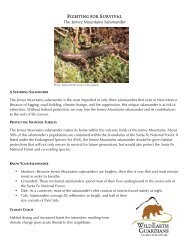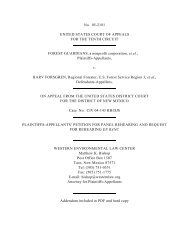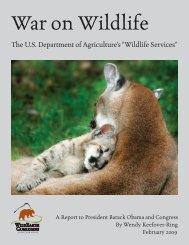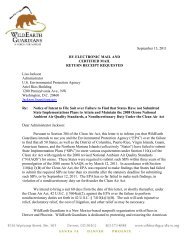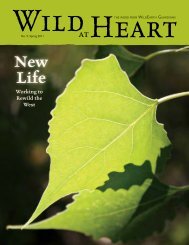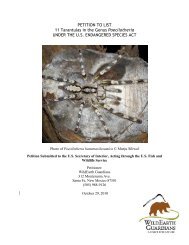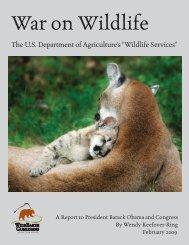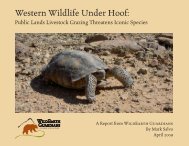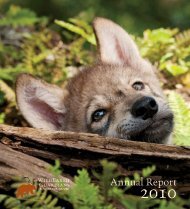PETITION TO LIST THE JEMEZ MOUNTAINS SALAMANDER ...
PETITION TO LIST THE JEMEZ MOUNTAINS SALAMANDER ...
PETITION TO LIST THE JEMEZ MOUNTAINS SALAMANDER ...
Create successful ePaper yourself
Turn your PDF publications into a flip-book with our unique Google optimized e-Paper software.
WildEarth Guardians Petition to List<br />
Jemez Mountains Salamander Under the ESA<br />
45<br />
the Valle II project was within the area designated as Essential Zone under the Jemez<br />
Mountains salamander CMP (Figures 4 and 5).<br />
In general the treatment prescriptions for ponderosa pine and ponderosa pine/mixed<br />
conifer forest types within the project area included:<br />
1) Thinning from below live trees and cutting dead trees to 40 trees per acre<br />
(TPA) within the wildland urban interface (WUI)<br />
2) Thinning from below live trees and cutting dead trees to 60-100 TPA outside of<br />
the WUI<br />
3) No removal of live trees and dead snags greater than 16” DBH<br />
4) Ground fuels would be removed to app 10-15 tons/acre (15 tons per acre is<br />
equal to 4-6 logs of 12-14” dbh) in all treatment areas<br />
5) Provide firewood and vigas for public collection<br />
6) Lop and scatter remaining slash<br />
7) Prescribed fire for slash piles in winter and broadcast burning<br />
8) On National Forest lands treatment will occur a max of 300’ from roads (Camp<br />
May and American Spring ) and 150’ from trails. Treatments on NPS lands<br />
would occur up to 400’ from St Rd 4<br />
9) Pp. 3-12 state that several historic records for Jemez Mountains salamander<br />
occur in the project area and that a 2001 survey of the project area resulted in<br />
several new locations. The Valle II EA proposed to protect Jemez Mountains<br />
salamander by allowing no thinning, firewood collecting, or prescribed burning<br />
in occupied habitat during the summer rainy season and additional vehicle<br />
restrictions on the Pipeline Road<br />
Before the Cerro Grande fire the NMEST supported the Valle II treatment but requested:<br />
1) USFS, USFWS, and NMDGF cooperate in developing long-term studies to<br />
investigate post-fire (low-to-moderate intensity prescribed broadcast burns)<br />
habitat trends and Jemez Mountains salamander persistence<br />
2) Additional 2-hr high-grade searches be conducted in un-surveyed areas prior<br />
to project implementation<br />
3) Ground-disturbing activities be precluded in occupied habitat during the<br />
summer monsoon season (1 July – Sept 30)<br />
4) Further consultation and coordination with the NMEST and USFS to develop<br />
a complete inventory on salamander localities on the project site map, and<br />
further discussion regarding final design and implementation of the project.<br />
In an April 2001 memo from the USFS to the NMEST, the USFS committed to following<br />
these guidelines:<br />
1) Un-surveyed areas: between 1 July and 30 September, no equipment or<br />
ground disturbance in Essential salamander habitat. This would apply to fuel<br />
break development, thinning, and other treatments. Tree felling and lopping<br />
would be allowed.



